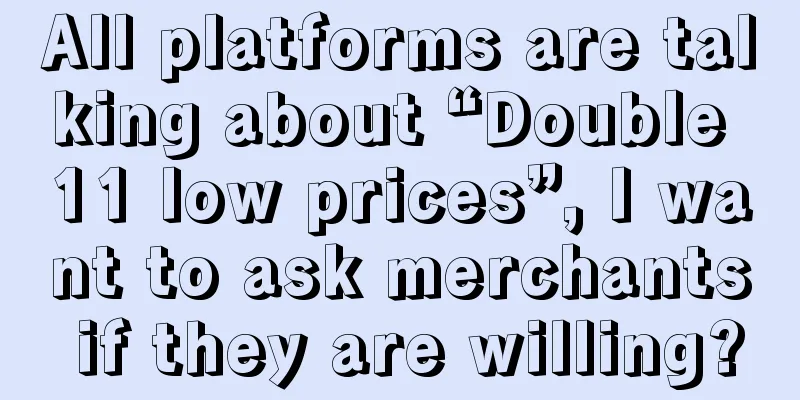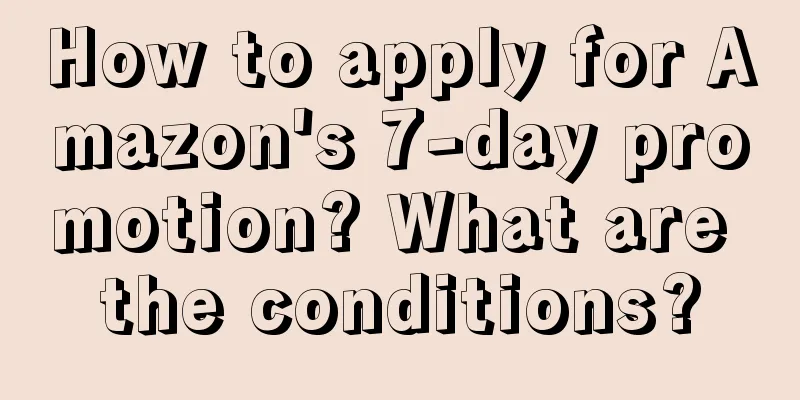All platforms are talking about “Double 11 low prices”, I want to ask merchants if they are willing?

The original intention of Double 11 is undoubtedly to offer low prices. On November 11, 2009, Taobao Mall offered 50% off on all items with free shipping nationwide, which marked the beginning of Double 11. The activity was not new, but the platform and merchants jointly offered discounts and promotions, sincerely giving benefits to consumers, which led to an instant explosion of demand. Fifteen years have passed, and various players have continued to pour in, various routines and gameplays have competed to appear on the stage, and the new and old money have fought overtly and covertly to compete for the main field of Double 11. But at the same time, the Double 11, which was once the center of attention, is gradually becoming dim, or even silent. This year, e-commerce platforms have once again raised the banner and collectively emphasized low prices. Recently, major e-commerce platforms have launched a variety of preferential policies such as cross-store discounts, instant discounts for one item, consumer coupons, shopping credits, and big brand subsidies, emphasizing that they are the "lowest prices on the entire network." If low prices are restored, it will undoubtedly be a shot in the arm for Double 11. But the question is, when all major platforms are shouting "the lowest price on the entire network", who is the lowest price on the entire network? If the platform wants to offer low prices, will the merchants agree? Where do low prices come from? Whose feast is it? 1. Everyone is talking about “low price”, who has the lowest price on the entire network?The annual Double 11 is coming. Kuaishou e-commerce has taken the lead on October 18, followed by Douyin e-commerce and JD.com on the 20th. Tmall also started the Double 11 pre-sale on the 24th. This year, Taobao Double 11 canceled the pre-sale period and started on time at 20:00 on October 31. All e-commerce platforms are gearing up for the event. Although the event time varies, they all aim at one direction to attract customers for the big promotion - low prices.
In this regard, people in the e-commerce industry commented that "the entire network is now Pinduoduo-like." Since the "low price" tone has been set, the promotion methods of e-commerce platforms, price verification before the promotion, and support and subsidies during the promotion are all determined around price. Taking Taobao and Tmall as an example, on Double 11, Taobao and Tmall will add two new categories of low-price products: one is "official instant discount", where the price of a single product is directly reduced by more than 15%, without the need to cross stores to make up for the discount; the other is "network-wide low price", and a new event called "Double 11 Everyday Low Price" will be added during the same period. Participating products are "four-star (same low-priced product)" and "five-star products (network-wide low-priced products)" among the five-star price power products, and will receive clear weighted traffic, and the recommended position will even be better than the full-discount and instant discount products. "The requirement of the storekeeper for us is that the price is at least the same as other platforms. This year, Tmall Double 11 price verification requires a 10% discount on the price after coupons to register. For example, if the daily price is 339 yuan, the platform will allow you to register for Double 11 at a 10% discount on the 339 yuan price, and then directly reduce it by 15% on this basis. "A Tmall clothing merchant told Yibang Power. Douyin e-commerce was the first to cancel the Double 11 promotion and focus on "official instant discounts starting from 15%". Consumers do not need to place orders in bulk, and can get instant discounts for each item. The platform also provides platform coupons with denominations ranging from 30, 100, and 120 yuan, further increasing the discounts consumers get when shopping. Compared with Tmall's Double 11 price verification, Douyin e-commerce's low price requirements are slightly looser. Douyin's Double 11 lowest page price is taken from the verification period, based on the lowest price of the page price (not the price after coupon) of the product displayed to users on Douyin e-commerce. The Double 11 event price is reduced by 15% based on the lowest price. Merchants feel that the platform's attitude is that "Douyin also requires low prices, in line with Tmall." In terms of rules, Douyin's price verification does not include page prices in some scenarios, including platform deposit pre-sales, platform direct discount subsidies, group purchases, expert exclusive prices, value-for-money purchase channels, low-price flash sale channels (hot-selling flash sale parts), one-cent purchases, lottery purchases, member sampling, member lottery purchases, and member points purchases. The "low price" strategies of JD.com and Kuaishou are somewhat similar, focusing on large subsidies, traffic support and price guarantee services. Kuaishou said it will "invest unprecedented resources", including 18 billion in traffic dividends and 2 billion in subsidies, launch activities such as big brand subsidies, and corresponding genuine insurance services. As early as October 16, JD.com announced that the theme of this year's "Double 11" is "Real Cheapness" and will invest 2 billion in subsidies. JD.com Live will invite 10 industry top anchors and celebrity anchors such as Luo Yonghao, Yu Dagongzi, Jin Xing, Huang Shengyi and Yang Zi to broadcast live non-stop during Double 11. The specific requirements for live streaming investment are that the price must meet the lowest price on the entire network after benchmarking against Tmall’s official flagship store, Pinduoduo’s black label store, and Douyin’s entire network, and the product must also have a price guarantee for the entire Double 11 period. 2. Are merchants willing to compete on low prices on the platforms?On the eve of Double 11, a Taobao merchant told Yibang Power: "(The platform clerk) sent out the form and notified the merchants that the price was too high. You either change the price or remove the product from the shelves. We have no choice but to give in (change the price)." Another clothing merchant said that he received a call from Tmall's clerk, saying that he was not satisfied with the current promotional price given by the merchant. The reason was that the merchant did not participate in the Double 11 product registration, but planned to directly reduce the daily price by 15%, and the overall price was slightly lower than the daily discount price. But the waiter suggested that even if the price could not be reduced too much, he still hoped to sign up for the 10 billion subsidy and other special activity areas to match the platform rhythm and gameplay of Double 11. The waiter's suggestions were all rejected. "The price cannot be changed, follow ours. The commission deduction of 10 billion subsidy is higher." He told Yibang Power that if he did not participate in the product registration at present, the only loss would be the Double 11 "skin" (big promotion label). The merchant also operates on Douyin. "It's the same with Douyin, the price is benchmarked against Tmall. But there is no way, (the price) can't be lower." He said, "This year, our Douyin and Tmall channel prices are consistent, the difference is only a few cents at most. Another JD sports merchant had a similar experience. On the first day of the Double 11 shopping festival, JD added new category coupons to boost sales, further reducing the price for consumers. In response, the merchant urgently communicated with JD staff and removed all the products in the store from the scope of application of the coupon. "But some customers who have already received the coupon (will get a lower price)." Douyin is also trying to get low prices. A Douyin channel operator of a brand told Ebrun: "It is mainly the several channels and support plans of the mall, such as the Super Value Purchase and Million-Product Plan, as well as the prices of the live broadcast rooms of major anchors. If they do not ask for the lowest price on the entire network, they will ask for an exclusive mechanism on the entire network. Some anchors are particularly closely bound to some merchants. After the event price is added with the anchor subsidy, the price is still very competitive." Pan Yurun is the top live-streaming anchor on Douyin. She has collaborated on some products from brands such as Kelijin, Tingyan, and Hongzhi. Her main products and gifts are differentiated from other channels. The anchor team also provides cashback subsidies of 219.9 yuan off for purchases over 1999 yuan, red envelopes in the live-streaming room, etc. Users can use the discount to deduct the money when shopping, or get cash back after receiving the goods. On one hand, there are the price requirements of the platform and the price pressure from the anchors, and on the other hand, there is price competition from peers, so merchants have to change their prices. A merchant in the cultural and educational category has been deeply trapped in the price war this year. "The original customer unit price of 4,000 yuan has been reduced to 1,850 this year. Last year's annual sales volume was 100 million yuan, but this year's monthly sales volume is only 3 to 4 million yuan. In order to recover funds (this year's Double 11), we usually offer 20% and 50% discounts, and during activities we will offer free orders (to stimulate orders)." The low-price orientation of the platform has aggravated the phenomenon of "channel price chaos" to a certain extent. A merchant told Yibang Power: "My Tmall store was directly affected by the C store and had no conversion. The same product, I sold for 8,000 yuan, and the C store sold for 4,500 yuan. Even if a god came, it would not sell well." The current situation is that the official flagship store has commissioned a third party to strictly investigate the channel price chaos, and the channel store owners have asked the customer service staff to keep a close eye on the official flagship discounts, and immediately ask and follow up if there is any sign of trouble. The price competition among major e-commerce companies may have driven the internal competition among dealers and factories. An e-commerce operator of a brand said: "Low prices have pushed the manufacturers to the limit, forcing them to give up their channel capabilities. Either the platform will take over, or the middlemen will be killed directly." Another e-commerce operator said that after implementing a low-price strategy this year, price comparisons have become more frequent than in previous years. "For people like us who sell general merchandise, we have multiple suppliers for one product and we have no control over it at all." Low prices have caused dissatisfaction among some merchants, but they have also brought opportunities to some merchants. Industry insiders believe that the platform supports low prices and is more friendly to new merchants, C-store merchants and white-label merchants. A 3C digital merchant said: "Taobao wants to have five-star pricing power, but all the benefits are reaped by C-stores. C-stores can set prices at will and move to another place after making a profit. Now it is fast to open a store. It takes only five minutes to register a store. There are also platform subsidies, and the store deposit is also low." Another e-commerce practitioner said that new merchants are the key targets of support from all major online platforms, which is also the background reason for the introduction of the low-price strategy. "When new merchants first enter the market, they are often willing to make concessions and offer low prices, so as to seize market share faster and gain a higher position. In this way, the platform can provide consumers with more attractively priced goods and support the original target merchants, achieving two goals at once," he said. When it comes to the sales forecast for this year's Double 11, most merchants are expecting an increase. A Taobao merchant joked, "Our goal is not only to increase year-on-year, but also month-on-month, but we can't achieve it in any channel. Regular meetings are all about reviewing why we didn't achieve (the goal)." During the Tmall 618 and 99 promotions this year, a certain men's clothing brand's performance was the same as last year without any price cuts. This year, they set a goal of 30% growth for Double 11, with Douyin as the main channel. With the platform's strict price control, can they still make money on Double 11 this year? Most merchants answered, "Of course they can still make money, but not as much." 3. Where do the low prices come from and whose feast is it?Low prices are becoming the killer weapon of major e-commerce platforms. On Double 11 in 2023, the platforms were "competing" severely on the issue of price. JD.com, Taobao Tmall, and Douyin e-commerce all launched their own subsidy support policies, and continued to exert efforts on the consumer side, merchant side, anchor side, and channel side to compete for the "lowest price on the entire network." In addition to Double 11, even in daily sales, major e-commerce platforms are accustomed to playing the "price card". Retaining users by low prices, with users, there is a possibility of future business, but the question is, if the platform is emphasizing low prices, then where do the low prices come from? A common saying is that it relies on suppressing suppliers' prices, but the problem is that suppliers are selling at low prices, and their net profit level is not high. If the platform continues to suppress prices, it will be like killing the goose that lays the golden eggs. Does it rely on the platform to reduce commissions to provide subsidies? In the context of all major platforms reducing costs and increasing efficiency, support may not be sustainable. If it is a short-term low price, it can rely on the introduction of new merchants. These new merchants may offer lower prices in order to gain a higher position and grab the market, but this is not a long-term solution. In addition, in the past few years, some businesses have indeed replaced cheaper materials and designs in exchange for lower prices, but this has been followed by a surge in return rates. (See "Return rate exceeds 80%, logistics and express delivery are just scapegoats丨Ebrun in-depth") Take the beauty industry as an example. In order to maintain prices and meet low price requirements, last year's Double 11, many businesses gave away samples when buying formal wear. This year's Double 11, buy formal wear and get formal wear. So, what should be done for next year's Double 11? Buy formal wear and get more formal wear? After communicating with industry insiders, Yibang Power found that everyone agreed that the "low price" most likely comes from two sources: first, reducing the internal operating costs of e-commerce, including new product research and development costs, promotion costs, after-sales and other aspects. In recent years, the gross profit margin of e-commerce has been high, but the net profit has been very low, because advertising fees, product testing and R&D, inventory and after-sales costs remain high. If these costs can be saved, the return rate can be reduced, the conversion rate can be increased, and the probability of new product promotion can be increased, then there is still room for low prices. An original design cosmetics brand said, "Mold making and designing samples are very expensive. One SKU costs hundreds of thousands. There are more than ten shades of lip gloss, and a batch of new products costs millions." The cost of developing new products is high, but the probability of success of new cosmetics is extremely low. The industry generally believes that the overall survival rate of new products is about 10%. In 2017, Nielsen, a research organization, tracked 25,473 new products launched in China and found that 70% of them survived for less than 18 months. The success rate of new products in the cosmetics industry is low, so all new product R&D costs will be allocated to the prices of other products and become fixed costs for the company. If new products can be continuously iterated and successfully promoted every year instead of becoming slow-selling and average-selling products, merchants will not have to worry about the vortex of price wars. Second, reduce the cost and loss of supply chain turnover, including improving the efficiency of the production end through digitalization, and reducing the turnover of goods, information and funds through models such as DTC. In the past, many middlemen such as buyers, distributors, and regional agents linked the production end and the consumption end. The retail prices seen by consumers were all marked up by middlemen, and the production end sacrificed first-hand user feedback and agile market response speed. When the market is oversupplied, products may be unpopular or the prices may be pushed down by buyers, resulting in very limited profits. For a long time, the rise of the Internet and e-commerce has mainly eliminated the middlemen in the circulation of goods. However, the market has the attribute of information asymmetry, which means that even products sold on e-commerce sometimes have to go through multiple middlemen before they can be delivered to consumers. This is why many e-commerce products are more expensive than offline channels. When factories and industrial belts go to major e-commerce platforms, they can directly recommend special products to consumers, use new digital means and logistics efficiency to achieve direct supply from the place of origin, skip the layers of price increases by middlemen, and rely on small profits but quick turnover to open up business. With the Double 11 test approaching, e-commerce platforms such as Tmall, JD.com, Douyin e-commerce, and Kuaishou e-commerce are all working hard. Based on the low-price mentality, Tmall and Taobao also emphasize that they are the main battlefield for merchants and can bring certain growth to merchants; JD.com emphasizes that it is the first choice for merchants to operate, and the platform has good products at low prices; Douyin e-commerce claims that it is the only place where merchants can increase their sales this year; Kuaishou e-commerce mainly promotes big brands and strives to build a platform impression of "a good life can be inexpensive." So, who do you think is the best? Author: Liao Zilin Source: WeChat public account "Ebrun Power (ID: iebrun)" |
>>: If you understand the money-making logic of advertising, you can make money!
Recommend
Is Amazon related because of a single factor? Why is it related?
On the Amazon platform, both consumers and merchan...
Is it easy to do business on Taiwan Shopee? What are the advantages?
If you want to do cross-border e-commerce, there a...
How many words should be put in an Amazon ad group? How many SKUs should be put?
In Amazon's advertising strategy, the setting ...
How much is the salary of the cross-border e-commerce operation department? What is the content of the operation work?
The rapid development and expansion of the cross-b...
How long does it take for eBay to stop posting comments? How to choose products?
There are actually quite a lot of merchants openin...
How did boiled water become so successful that it sells 3 billion yuan a year through marketing?
In recent years, a new product has emerged in the ...
“Arguing” with celebrities and complaining about UP hosts becomes a “high-risk” job?
This article deeply analyzes the conflict between ...
How to operate Temu EU agent?
Temu, as an emerging cross-border e-commerce platf...
What are the risks of opening a wish store? Share the factors that lead to the risks of a wish store
I believe everyone should know that the Wish platf...
How to collect payments when running a local store on Shopee? How does the Shopee platform transfer payments?
There are two types of stores on the Shopee platfo...
A short drama made a city popular. Is it a real trend or a false concept?
Cultural tourism and short plays have been hot tra...
Can shein operate without a source of goods? How can I enter shein without a factory?
Some people may ask, can Shein do no-source? This ...
What is Amazon Transparency and how does it work?
Amazon is a cross-border e-commerce platform that ...
Can Amazon still do it in 2024?
As one of the world's largest e-commerce platf...
What are the channels that Amazon often uses to select products? What is Amazon FBA?
Product selection is a crucial step in successfull...









